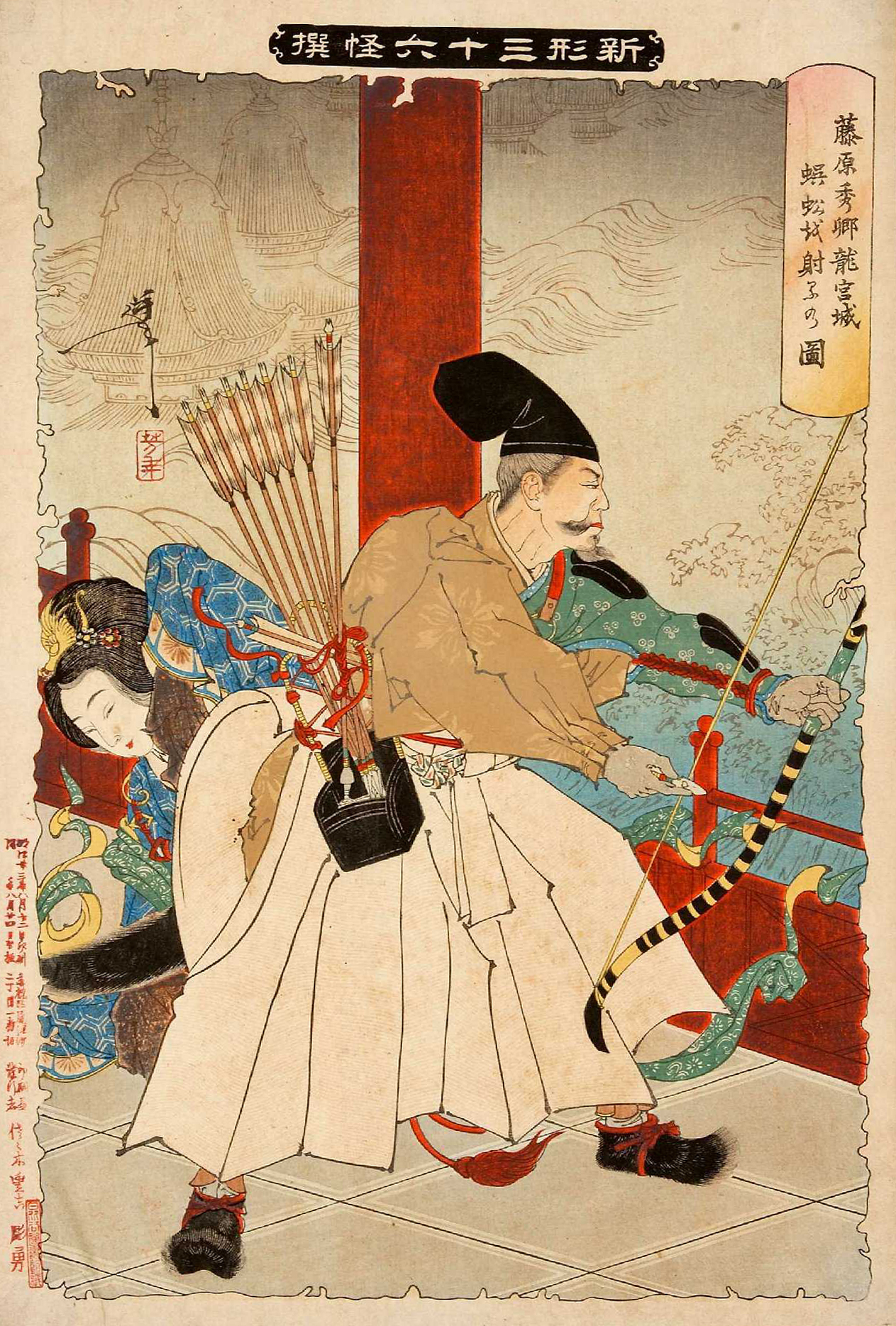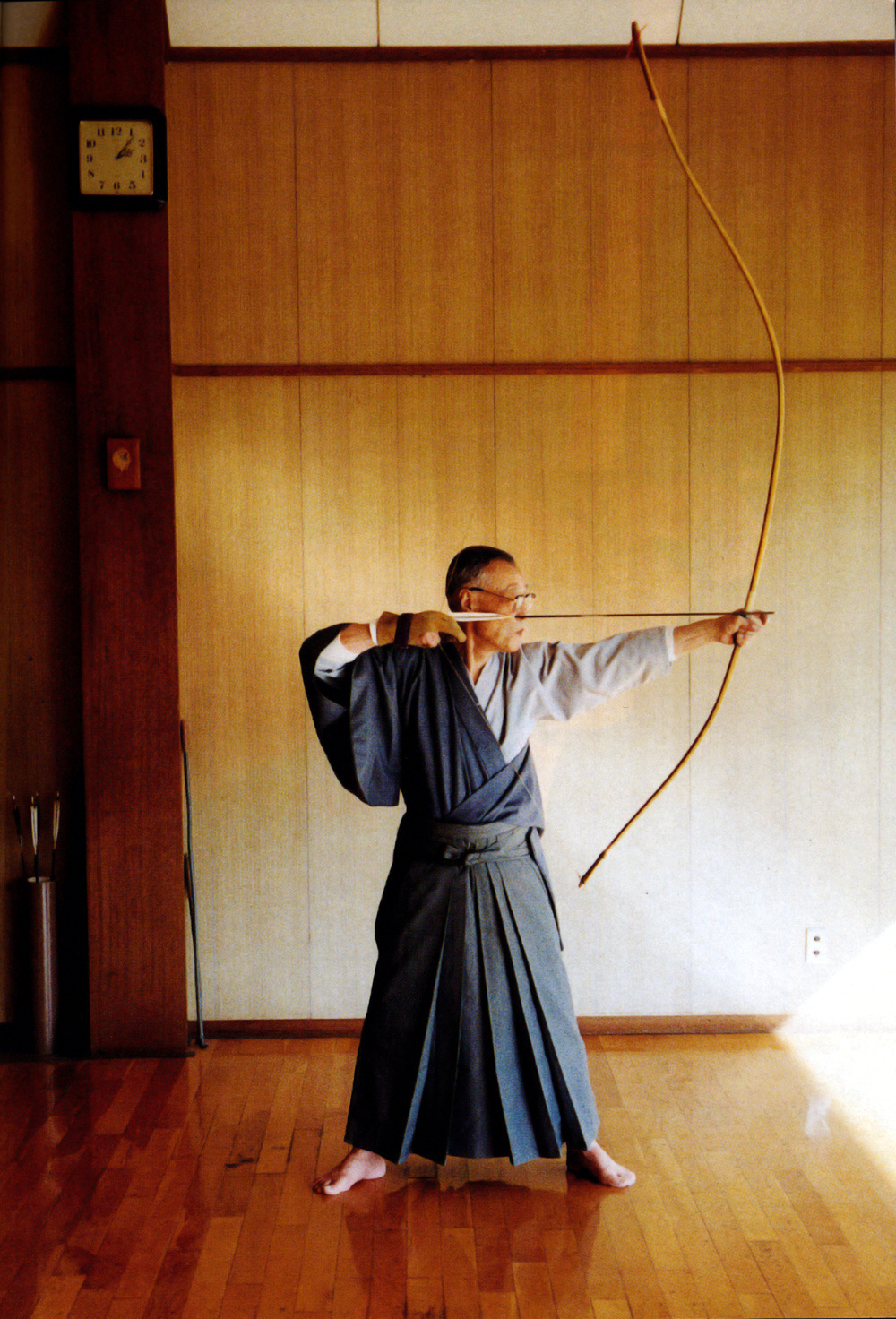|
Yazutsu
or ''Yadzutsu'' is a type of arrow quiver used in kyūdō, Japanese archery, using the Japanese longbow A longbow is a type of tall bow that makes a fairly long draw possible. Longbows for hunting and warfare have been made from many different woods in many cultures; in Europe they date from the Paleolithic era and, since the Bronze Age, were mad ..., the Yumi. It is generally cylindrical in shape, and zippered at the top, and appears something like a cylindrical holder of plans. As ''kyūdō ya'' (arrows) are quite long, the ''yazutsu'' is quite long compared to quivers from other styles of archery. Traditional ''yazutsu'' are made of cloth/satin or leather, modern ones are often made of synthetic material. They are often decorated with cord. In kyūdō the ''yazutsu'' is generally just used to carry the arrows to the dōjō. Once in the dōjō, they are held in the hand or placed on the ground for actual nocking and shooting. Traditional archers may use another type of ... [...More Info...] [...Related Items...] OR: [Wikipedia] [Google] [Baidu] |
Yebira
, and are types of quiver used in Japanese archery. The quiver is unusual in that in some cases, it may have open sides, while the arrows are held in the quiver by the tips which sit on a rest at the base of the ebira, and a rib that composes the upper part and keeps them in place. There are many types of ebira, some more ornate, some ceremonial, some more plain. Other types of ebira are more substantial and more boxlike, much like quivers from other countries. The ebira was used traditionally by samurai in combat or hunting, and also is used for ceremonial archery in modern-day Japan, such as in yabusame. It could be quite decorative. It is completely different from the cylindrical yazutsu, which is used only for carrying Kyūdō arrows. Some ebira could hold up to three dozen arrows. The ebira can be slung over the back, or kept on saddle by Yabusame, horse archers. Gallery File:Yebira utsubo 1.JPG, Utsubo type quiver File:Yebira yazutsu or yadzutsu 2.JPG, Yazutsu or yad ... [...More Info...] [...Related Items...] OR: [Wikipedia] [Google] [Baidu] |
Quiver
A quiver is a container for holding arrows or Crossbow bolt, bolts. It can be carried on an archer's body, the bow, or the ground, depending on the type of shooting and the archer's personal preference. Quivers were traditionally made of leather, wood, furs, and other natural materials, but are now often made of metal or plastic. Etymology The English word quiver has its origins in Old French, written as quivre, cuevre, or coivre. Types Belt quiver The most common style of quiver is a flat or cylindrical container suspended from the belt. They are found across many cultures from North America to China. Many variations of this type exist, such as being canted forwards or backwards, and being carried on the dominant hand side, off-hand side, or the small of the back. Some variants enclose almost the entire arrow, while minimalist "pocket quivers" consist of little more than a small stiff pouch that only covers the first few inches. The Bayeux Tapestry shows that most bowme ... [...More Info...] [...Related Items...] OR: [Wikipedia] [Google] [Baidu] |
Kyūdō
''Kyūdō'' () is the Japanese martial art of archery. Kyūdō is based on ''kyūjutsu'' ("art of archery"), which originated with the samurai class of feudal Japan. In 1919, the name of kyūjutsu was officially changed to kyūdō, and following the example of other martial arts that have been systematizing for educational purposes, kyūdō also reorganized and integrated various forms of shooting that had been used up until then. Many practitioners may refer to themselves as ''yumihiki'' (弓引き), or 'ones who draw the bow'. Kyūdō is practised by over a hundred thousand people worldwide. The bow they use is called a . It has an asymmetrical shape and length of more than , and its use is characterized by the archer gripping the lower third of the bow stave to shoot. History The beginning of archery in Japan is pre-historical. The first images picturing the distinct Japanese asymmetrical longbow are found on Dōtaku from the Yayoi period (c. 500 BC – 300 AD). Emerge ... [...More Info...] [...Related Items...] OR: [Wikipedia] [Google] [Baidu] |
:Category:Japanese Words And Phrases ...
{{Commons Words and phrases by language Words Words Words A word is a basic element of language that carries meaning, can be used on its own, and is uninterruptible. Despite the fact that language speakers often have an intuitive grasp of what a word is, there is no consensus among linguists on its ... [...More Info...] [...Related Items...] OR: [Wikipedia] [Google] [Baidu] |
Archery
Archery is the sport, practice, or skill of using a Bow and arrow, bow to shooting, shoot arrows.Paterson ''Encyclopaedia of Archery'' p. 17 The word comes from the Latin ''arcus'', meaning bow. Historically, archery has been used for hunting and combat. In modern times, it is mainly a competitive sport and recreational activity. A person who practices archery is typically called an archer, bowman, or toxophilite. History Origins and ancient archery The oldest known evidence of arrows (not found with surviving bows) comes from South Africa, South African sites such as Sibudu Cave, where the remains of bone and stone arrowheads have been found dating approximately 72,000 to 60,000 years ago.Backwell L, d'Errico F, Wadley L.(2008). Middle Stone Age bone tools from the Howiesons Poort layers, Sibudu Cave, South Africa. Journal of Archaeological Science, 35:1566–1580. Backwell L, Bradfield J, Carlson KJ, Jashashvili T, Wadley L, d'Errico F.(2018). The antiquity of bow-and-arro ... [...More Info...] [...Related Items...] OR: [Wikipedia] [Google] [Baidu] |
Metropolitan Museum Of Art
The Metropolitan Museum of Art, colloquially referred to as the Met, is an Encyclopedic museum, encyclopedic art museum in New York City. By floor area, it is the List of largest museums, third-largest museum in the world and the List of largest art museums, largest art museum in the Americas. With 5.36 million visitors in 2023, it is the List of most-visited museums in the United States, most-visited museum in the United States and the List of most-visited art museums, fifth-most visited art museum in the world. In 2000, its permanent collection had over two million works; it currently lists a total of 1.5 million works. The collection is divided into 17 curatorial departments. The Met Fifth Avenue, The main building at 1000 Fifth Avenue, along the Museum Mile, New York, Museum Mile on the eastern edge of Central Park on Manhattan's Upper East Side, is by area one of the world's list of largest art museums, largest art museums. The first portion of the approximately building ... [...More Info...] [...Related Items...] OR: [Wikipedia] [Google] [Baidu] |
Longbow
A longbow is a type of tall bow that makes a fairly long draw possible. Longbows for hunting and warfare have been made from many different woods in many cultures; in Europe they date from the Paleolithic era and, since the Bronze Age, were made mainly from yew, or from wych elm if yew was unavailable. The historical longbow was a self bow made of a single piece of wood, but modern longbows may also be made from modern materials or by gluing different timbers together. History Europe Prehistory A longbow was found in 1991 in the Ötztal Alps with a natural mummy known as Ötzi. His bow was made from yew and was long; the body has been dated to around 3300 BC. A slightly shorter bow comes from the Scottish parish of Tweedsmuir in a peat bog known as Rotten Bottom. The bow, made from yew, has been given a calibrated radiocarbon date of 4040 BC to 3640 BC. Another bow made from yew, found within some peat in Somerset, England has been dated to 2700–2600 BC. Forty longbo ... [...More Info...] [...Related Items...] OR: [Wikipedia] [Google] [Baidu] |
Yumi
is the Japanese term for a bow. As used in English, refers more specifically to traditional Japanese asymmetrical bows, and includes the longer and the shorter used in the practice of and , or Japanese archery. The was an important weapon of the samurai warrior during the feudal period of Japan. It is typically shot with Japanese arrows known as . The most famous style of is an asymmetrically shaped long bow with a length of more than , characterized by the archer holding the part of the bow below the center to shoot the arrow. History Most of the excavated Jōmon period () bows are in length, while most of the Yayoi period () bows are in length. The bows in these periods were made from a single processed wood, and the bows with this structure were called and were used until the Nara period (710–794 CE). It is unknown when the asymmetrical came into use, but the first written record is found in the ''Book of Wei'', a Chinese historical manuscript dating to the ... [...More Info...] [...Related Items...] OR: [Wikipedia] [Google] [Baidu] |
Dōjō
A is a hall or place for immersive learning, experiential learning, or meditation. This is traditionally in the field of martial arts. The term literally means "place of the Way" in Japanese. History The word ''dōjō'' originates from Buddhism. Initially, ''dōjō'' were adjunct to temples and were formal training places for any of the Japanese arts ending in "''-dō''", from the Chinese '' Dao'', meaning "way" or "path". Sometimes meditation halls where Zen Buddhists practice ''zazen'' meditation were called ''dōjō''. The alternative term '' zen-do'' is more specific, and more widely used. European ''Sōtō Zen'' groups affiliated with the International Zen Association prefer to use ''dōjō'' instead of ''zendo'' to describe their meditation halls as did their founding master, Taisen Deshimaru. In Japan, any facility for physical training, including professional wrestling, may be called a ''dōjō''. In the Western world, the term ''dōjō'' (when related to phys ... [...More Info...] [...Related Items...] OR: [Wikipedia] [Google] [Baidu] |
Maki-e
is a Japanese lacquerware, Japanese lacquer decoration technique in which pictures, patterns, and letters are drawn with lacquer on the surface of lacquerware, and then metal powder such as gold or silver is sprinkled and fixed on the surface of the lacquerware. The origin of the term ''maki-e'' is a compound word of ''maki'' meaning "sprinkling" and ''e'' meaning "picture" or "design". The term can also be used to refer to lacquerware made with this decorative technique. The term first appeared in the Heian period.Maki-e. This technique is the most used technique in Japanese lacquer decoration. The is often combined with other techniques such as in which a nacreous layer of mother of pearl, mollusk shell lining is embedded or pasted in lacquer, in which metal or ivory is embedded in lac ... [...More Info...] [...Related Items...] OR: [Wikipedia] [Google] [Baidu] |
Edo Period
The , also known as the , is the period between 1600 or 1603 and 1868 in the history of Japan, when the country was under the rule of the Tokugawa shogunate and some 300 regional ''daimyo'', or feudal lords. Emerging from the chaos of the Sengoku period, the Edo period was characterized by prolonged peace and stability, urbanization and economic growth, strict social order, Isolationism, isolationist foreign policies, and popular enjoyment of Japanese art, arts and Culture of Japan, culture. In 1600, Tokugawa Ieyasu prevailed at the Battle of Sekigahara and established hegemony over most of Japan, and in 1603 was given the title ''shogun'' by Emperor Go-Yōzei. Ieyasu resigned two years later in favor of his son Tokugawa Hidetada, Hidetada, but maintained power, and defeated the primary rival to his authority, Toyotomi Hideyori, at the Siege of Osaka in 1615 before his death the next year. Peace generally prevailed from this point on, making samurai largely redundant. Tokugawa sh ... [...More Info...] [...Related Items...] OR: [Wikipedia] [Google] [Baidu] |







